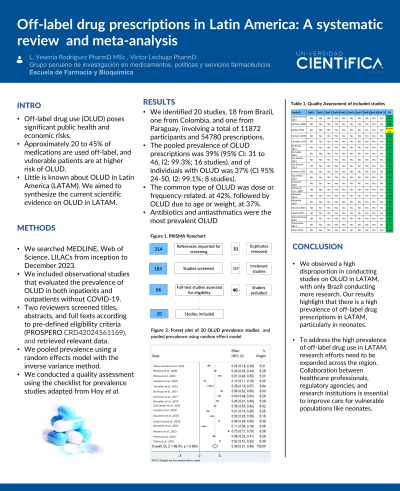Drug utilization research
Session: Poster Session A
(204) Off-label drug prescriptions in Latin America: a systematic review
Monday, August 26, 2024
8:00 AM - 6:00 PM CEST
Location: Convention Hall II


L. Yesenia Rodriguez, PharmD, MSc (she/her/hers)
Associated Research
Universidad Científica del Sur, Lima, Perú, Peru- VL
Victor Lechuga, PharmD
Instituto Nacional del Corazón, ESSALUD, Perú, Peru
Presenting Author(s)
Co-Author(s)
Background: Off-label use of drugs (OLUD) is a significant public health issue that may lead to negative clinical and economic consequences for patients and healthcare systems. OLUD occurs when a medication is used outside the label approved by any drug regulatory body. There is evidence that roughly 20 to 45% of medications are used off-label. Vulnerable populations, such as pediatric patients, are at higher risk of being exposed to OLUD. Little is known about OLUD in Latin America (LATAM).
Objectives: To synthesize the current scientific evidence on OLUD in LATAM
Methods: We performed a systematic review to determine the prevalence of OLUD prescriptions and individuals in LATAM. We searched MEDLINE, Web of Science, and LILACs for studies that reported the prevalence of OLUD in inpatients and outpatients without COVID-19 from the inception to December 2023. We retrieved relevant data and presented descriptive information of the selected studies. We pooled prevalence using a random effects model with the inverse variance method, estimating the confidence intervals with the Hartung-Knapp-Sidik-Jonkman method. We conducted a quality assessment using the checklist for prevalence studies adapted from Hoy et al.
Results: We included 20 studies involving 11872 participants and 54780 prescriptions in total. Studies were conducted in Brazil (18), Colombia (1), and Paraguay (1). Most studies described the OLUD in pediatrics and inpatients. Only one study reported the prevalence of OLUD in adults. The prevalence of prescriptions of OLUD was 39% (CI 95% 0.31 to 0.46, I2 99.3%; 16 studies). The prevalence of prescriptions of OLUD in neonates was 50% (CI 95% 0.47 to 0.53, I2 90.6%; 8 studies), and in pediatrics was 33% (CI 95% 0.24 to 0.42, I2 97.6%; 9 studies). In addition, the prevalence of individuals with OLUD was 37% (CI 95% 0.24-0.50, I2 99.1%; 8 studies). The pooled prevalence of neonates with OLUD was 48% (CI 95% 0.41 to 0.55, I2 88.6%;), and of pediatrics was 29% (CI 95% 0.12-0.45, I2 98.9%). The OLUD due to dose or frequency was the most frequent, with a pooled prevalence of 42% (CI 95% 0.38 to 0.46), while the prevalence of OLUD due to age or weight was 37% (CI 95% 0.26 to 0.49). Systemic ATB and antiasthmatic were the most prevalent OLUD in pediatrics and neonates.
Conclusions: We observed a high disproportion in conducting studies on OLUD in LATAM, with only Brazil being the country with more research. Our results highlight that there is a high prevalence of off-label drug prescriptions in LATAM, particularly in neonates.
Objectives: To synthesize the current scientific evidence on OLUD in LATAM
Methods: We performed a systematic review to determine the prevalence of OLUD prescriptions and individuals in LATAM. We searched MEDLINE, Web of Science, and LILACs for studies that reported the prevalence of OLUD in inpatients and outpatients without COVID-19 from the inception to December 2023. We retrieved relevant data and presented descriptive information of the selected studies. We pooled prevalence using a random effects model with the inverse variance method, estimating the confidence intervals with the Hartung-Knapp-Sidik-Jonkman method. We conducted a quality assessment using the checklist for prevalence studies adapted from Hoy et al.
Results: We included 20 studies involving 11872 participants and 54780 prescriptions in total. Studies were conducted in Brazil (18), Colombia (1), and Paraguay (1). Most studies described the OLUD in pediatrics and inpatients. Only one study reported the prevalence of OLUD in adults. The prevalence of prescriptions of OLUD was 39% (CI 95% 0.31 to 0.46, I2 99.3%; 16 studies). The prevalence of prescriptions of OLUD in neonates was 50% (CI 95% 0.47 to 0.53, I2 90.6%; 8 studies), and in pediatrics was 33% (CI 95% 0.24 to 0.42, I2 97.6%; 9 studies). In addition, the prevalence of individuals with OLUD was 37% (CI 95% 0.24-0.50, I2 99.1%; 8 studies). The pooled prevalence of neonates with OLUD was 48% (CI 95% 0.41 to 0.55, I2 88.6%;), and of pediatrics was 29% (CI 95% 0.12-0.45, I2 98.9%). The OLUD due to dose or frequency was the most frequent, with a pooled prevalence of 42% (CI 95% 0.38 to 0.46), while the prevalence of OLUD due to age or weight was 37% (CI 95% 0.26 to 0.49). Systemic ATB and antiasthmatic were the most prevalent OLUD in pediatrics and neonates.
Conclusions: We observed a high disproportion in conducting studies on OLUD in LATAM, with only Brazil being the country with more research. Our results highlight that there is a high prevalence of off-label drug prescriptions in LATAM, particularly in neonates.
